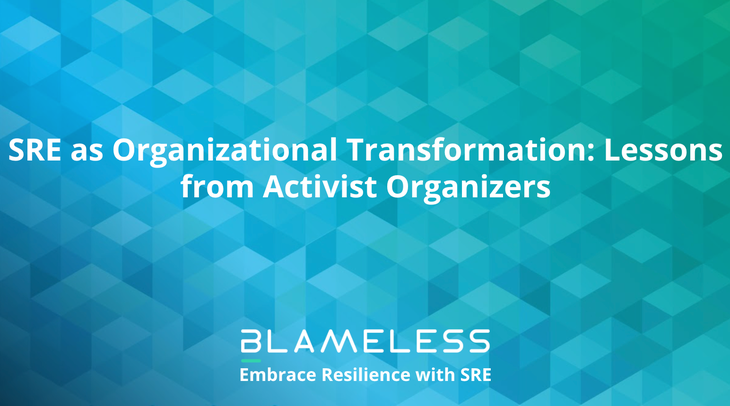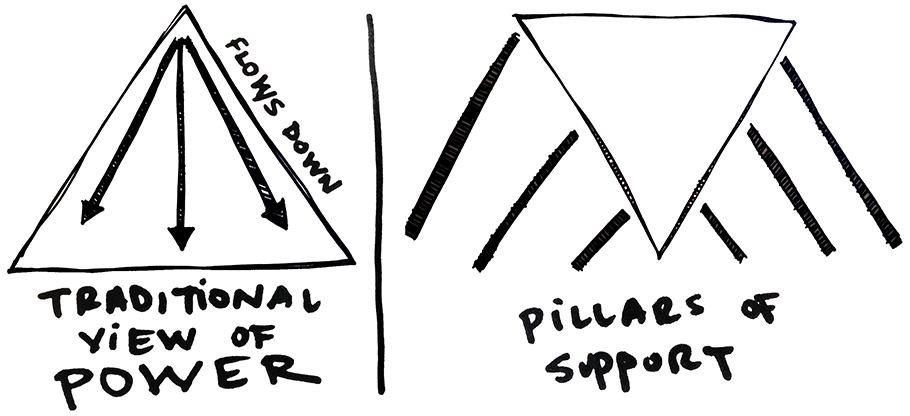SRE as Organizational Transformation: Lessons from Activist Organizers

Activist organizers are in the business of changing minds and behaviors, leading decision-makers and traditional power holders in new directions. Here’s a curated list of their tips and practices that you can use to bolster your company’s transformation efforts.
By: Chris Hendrix
In the software industry’s recent past, the biggest disruptive wave was Agile methodologies. While Site Reliability Engineering is still early in its adoption, those of us who experienced the disruptive transformation of Agile see the writing on the wall: SRE will impact everyone.
Any kind of major transformation like this requires a change in culture, which is a catch-all term for changing people’s principles and behaviors. As your organization grows, this will extend beyond product and engineering. At some point you also need to convince the key power-holders in your organization to invest in this transformation.
Folks who’ve been successful at managing these multi-year complex transformations point to a piece of invaluable advice: you must treat the transformation as its own project–with business outcomes, executive buy-in, and a project team. And there is an unexpected place to look for learning, strategy, and tactics to achieve this goal: activist organizing.
Activist organizers are in the business of changing minds and behaviors, leading decision-makers and traditional power holders in new directions. Here’s a curated list of their tips and practices that you can use to bolster your company’s transformation efforts.
Spectrum of Allies
Photo courtesy of 350.org
The main principle to the spectrum of allies is that some people are more aligned with your cause than others. People will range from active allies, passive allies, neutral, passive opposition, and active opposition. There’s a few lessons to take away from this concept:
- It’s most efficient to try to move someone only “one slice” closer to active allyship at a time.
- It’s not worth the energy to try to influence people who are actively opposed to your efforts! Target passive-opposition at the most.
- Tailor your message and your “ask” to where someone is on the spectrum. An active ally can be asked to amplify your efforts within your company. However, you’ll need to pay special attention to how you frame the outcomes of SRE adoption to a person of passive opposition.
People Power / Stay on Message
Executives and other decision-makers are examples of concentrated power. The major alternative to concentrated power is people power, or the power of numbers and organization. People power exists when many people are all organized to make the same request.
Your campaign’s passive and active allies should all be trained on the elevator pitch that answers “What business value will Site Reliability Engineering give us?” Those allies should then repeat that pitch, and any other messaging in every venue available, amplifying each other until you create a level of support that buildsheat on the decision-makers. At some point it will come to a boil and leaders will be forced to address the growing calls for SRE transformation.
Supporting Limbs of Power
Photo courtesy of 350.org
While framing your message appropriately and having intimate one-on-one conversations with those in charge can go a long way to build relationships and influence leaders, you will inevitably encounter someone who holds reservations about SRE adoption.
The traditional view of power thinks of a CEO at the top, giving orders to a VP who passes on orders to a director, then a manager, and finally an IC. This is a convenient mental model, but in the world of activism and organizers this view is disheartening. Instead, organizers have reframed the idea of concentrated power as being held up by various pillars of support. This support system can empower leaders to make choices that are beneficial to the organization as a whole, if they can be convinced of the campaign’s merit.
For example, while your SRE transformation effort might be targeting your CTO–a passive opponent– they might have the following pillars of support:
- An executive mentor from outside of the company
- An SVP who they rely on for guidance
- A COO who “executes orders”
- An executive assistant who controls their calendar
- A thought leader they regularly quote or follow on twitter
- An HR, finance, or legal business partner that holds them accountable
Get creative and you will quickly realize that there are many avenues for influence! You can first try meeting with those pillars of support. Any one of them you can bring into your campaign can have an outsized impact on amplifying your message with your target.
Start Small
Changing an organization doesn’t happen overnight, and while you work on influencing those in power, the best way to drive change is to start with what youcan impact.
While SLIs and SLOs often require a more substantial level of buy-in, it is very easy to start running blameless retrospectives after a production incident. You can begin to build the culture of SRE by reflecting on an incident and looking at the failures as systemic instead of individual.
Another practice that works on a team level is writing and using runbooks for common incident responses. Once you’ve shown the value of process repeatability and consistency that using runbooks has achieved for your team, you can leverage that experience when trying to convince others to adopt the same practice!
Book Clubs are Practical
Even after reading this post you may still feel daunted by the prospect of helping or leading your company to adopt SRE. It can be a long and arduous process but here’s one practical way you can kick it off: start a book club!
Book clubs are a great way to:
- Organize a group of people and build community
- Learn about a new skill, a new technology, or a new way of working
- “Get on message”
Book clubs–especially long-running ones that read multiple books in sequence–provide the seed that can germinate into a much larger effort. Make sure to stay in contact with participants, and utilize a chat or message group to strategize and execute your broader campaigns!
At Blameless, we’ve run book clubs for “Implementing Service Level Objectives” by Alex Hidalgo and “Shape Up” by Basecamp.
One final piece of advice is to lean on other people’s experiences! You aren’t alone in your journey and the people power behind SRE exists beyond the boundaries of your organization.
If you’re interested in learning more, we’ll be hosting a new SRE Thought Leader panel with industry experts who have experienced and helped drive this transformation. They’ve championed SRE adoption in companies like Goldman Sachs, LinkedIn, and Pivotal. Panelists include:
- Kurt Andersen, SRE Architect at Blameless
- Vanessa Yiu, Executive Director, Enterprise Architecture at Goldman Sachs
- Tony Hansmann, Former Global CTOat Pivotal Software, Inc.
- Chris Hendrix (Host), Staff Software Engineer at Blameless
Register here today.
Get similar stories in your inbox weekly, for free
Share this story:

Blameless
Blameless is the industry's first end-to-end SRE platform, empowering teams to optimize the reliability of their systems without sacrificing innovation velocity.
Latest stories
HIPAA and PCI DSS Hosting for SMBs: How to Choose the Right Provider
HIPAA protects patient data; PCI DSS protects payment data. Many small and mid-sized businesses now …
The Rise of GPUOps: Where Infrastructure Meets Thermodynamics
GPUs used to be a line item. Now they're the heartbeat of modern infrastructure.
Top Bare-Metal Hosting Providers in the USA
In a cloud-first world, certain workloads still require full control over hardware. High-performance computing, latency-sensitive …
Top 8 Cloud GPU Providers for AI and Machine Learning
As AI and machine learning workloads grow in complexity and scale, the need for powerful, …
How ManageEngine Applications Manager Can Help Overcome Challenges In Kubernetes Monitoring
We tested ManageEngine Applications Manager to monitor different Kubernetes clusters. This post shares our review …
AIOps with Site24x7: Maximizing Efficiency at an Affordable Cost
In this post we'll dive deep into integrating AIOps in your business suing Site24x7 to …
A Review of Zoho ManageEngine
Zoho Corp., formerly known as AdventNet Inc., has established itself as a major player in …
Should I learn Java in 2023? A Practical Guide
Java is one of the most widely used programming languages in the world. It has …
The fastest way to ramp up on DevOps
You probably have been thinking of moving to DevOps or learning DevOps as a beginner. …
Why You Need a Blockchain Node Provider
In this article, we briefly cover the concept of blockchain nodes provider and explain why …
Top 5 Virtual desktop Provides in 2022
Here are the top 5 virtual desktop providers who offer a range of benefits such …













